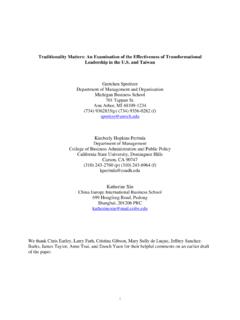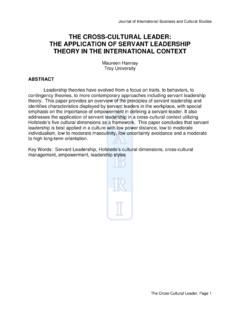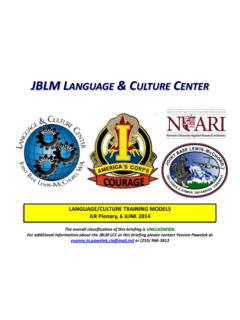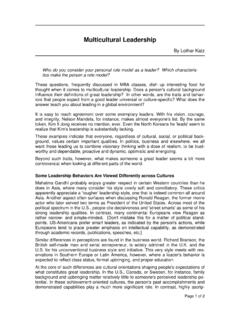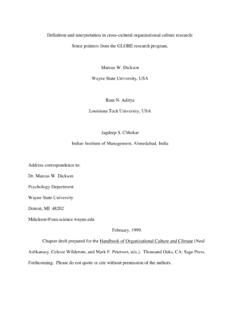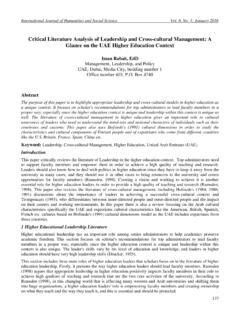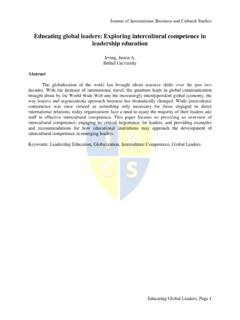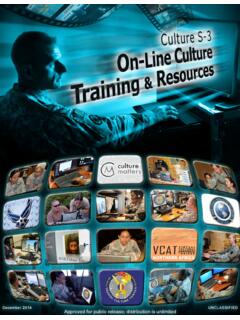Transcription of Talent Framework The Inclusive Leader - Korn Ferry
1 Talent FrameworkThe Inclusive LeaderOptimizing diversity by leveraging the power of leadership as a bottom-line, beneficial by itself is not enough: Leadership in the 21st-century demands that executives and their organizations move beyond diversity alone to capture the potential that comes from inclusion. If diversity is the mix, then inclusion is making the mix work by leveraging the wealth of knowledge, insights, and perspectives in an open, trusting, and diverse inclusion, organizations can capture a competitive advantage from changing demographics across the workplace and in the marketplace.
2 An organization with a reputation for inclusiveness becomes a magnet, attracting top diverse Talent ; in turn, that Talent can better tap markets potential, whether in emerging economies or among a broader set of consumers at home. A diverse Talent mix also can spark greater creativity and propel innovation that can help organizations distance themselves from their competition. But inclusion is a challenge in itself. Even leaders who fully embrace the business case for diversity understanding that homogeneous teams, although easier to manage, are more likely to result in group think often feel unprepared to be Inclusive .
3 When discussing this approach, Korn Ferry often hears this from clients across multiple industries: We don t have an understanding of what to do and how to do it differently. Companies in recent times have improved their recruiting and hiring of more diverse Talent . There is greater diversity today by gender, ethnicity, race, and sexual orientation than five or ten years ago at the entry and supervisory levels; overall, 50% of managers are women (International Labour Organization 2015), and people of color in the United States account for one-third of the labor force (Catalyst 2015).
4 But many organizations struggle to keep that Talent and advance it to positions of leadership and paper takes on the challenge of inclusion, with a specific focus on the traits and abilities necessary to become an Inclusive Leader . Korn Ferry research, including from mining more than million leadership assessments, identifies the traits and competencies needed for leaders to be Inclusive in their own thoughts, perceptions, and actions and to inspire an Inclusive mindset in others. Such leaders are self-aware advocates for diversity, and possess the skills to leverage the differences within the diverse team With inclusion, organizations can capture a competitive advantage from changing demographics across the workplace and in the marketplace.
5 An organization with a reputation for inclusiveness becomes a magnet, attracting top Inclusive LEADER2to achieve better performance than would occur with homogeneous teams. As shown below (Figure 11), homogenous teams in the early stages outperform diverse ones because of the disruption and conflict that can result when different perspectives, experiences, backgrounds, thinking, and communication styles are merged. But well-managed diverse teams can significantly outperform well-managed homogenous ones over time.
6 Figure 1 Impact of diversity on team The figure synthesizes the work on the performance of diverse versus homogenous teams by Katherine W. Phillips (October 2014), and Bruce Tuckman s Framework (1965) for the maturity over time of team paper also discusses Inclusive leadership within and across organizations in which teams are open and trusting, able to work inclusively, leverage diversity for greater adaptability, and achieve teamswell managedHomogenous teamswell managedProductivityFormingStormingNormin gPerforming321st Century Leadership The 21st century Leader is, by definition, an Inclusive Leader .
7 Korn Ferry research (Figure 2) has demonstrated that to face contemporary challenges, leaders today must excel in four areas simultaneously: global, in growth, in change, and with innovation. In each dimension, inclusiveness is a must. The ideal global Leader exhibits cross - cultural agility, can see workplace situations from others perspectives, and can accept different beliefs and behaviors in addressing business challenges. A growth Leader pursues diverse consumers whose aspirations, needs, wants, and desires can vary widely from those of traditional and legacy consumers and customers.
8 A change Leader can hire sufficient skilled Talent from all pools, master the ability to inspire and motivate others in an environment of unprecedented diversity, manage organizational cultural differences in the midst of complex mergers and acquisitions, and lead teams with multiple nationalities. An innovation Leader can move from diversity to inclusion by inviting out-of-the-box perspectives. This Leader also gives permission to those who don t adhere to the status quo so their voices are heard, recognizing them as catalysts for 2 Korn Ferry research: 21st-century leaders needed todayPurple text highlight Inclusive leaders behaviors.
9 Attract global Talent , operate across boundaries, meet diverse customer needs Require global perspective, cultural agility, self-awareness, openness, and flexibility Depend on their capable, self-directed teams Pivot the organization in anticipation of or in response to market changes Swiftly change the business model and lead competitors because of adaptability and foresight Master the ability to inspire and motivate people in a dynamic environment with unprecedented diverse teams View problems as challenges to be overcome Use technology for new products/services Work hard to stay in front of trends by creating new markets Open to diverse points of view Thrive in new, complex.
10 And crowded business environments See and understand how to reach, design for, and serve traditionally underrepresented consumers and clients Grow business under difficult circumstances that may involve a lack of resources, fierce competition, or razor-thin marginsGlobal leadersChange leadersInnovation leadersGrowth leaders4 THE Inclusive LEADERA lthough it has its own challenges, moving from diversity to inclusion can have a multiplier effect on the workforce. Research shows that when employees work with and for an Inclusive Leader , there are high-impact benefits, including improved collaboration, higher performance and productivity, greater engagement and loyalty, increased motivation, greater innovation and creativity, and enhanced potential to capture market share (Opportunity Now and Shapiro Consulting 2015).
